
- •Study Skills Workshop
- •1.1 An Introduction to the Whole Numbers
- •1.2 Adding Whole Numbers
- •1.3 Subtracting Whole Numbers
- •1.4 Multiplying Whole Numbers
- •1.5 Dividing Whole Numbers
- •1.6 Problem Solving
- •1.7 Prime Factors and Exponents
- •1.8 The Least Common Multiple and the Greatest Common Factor
- •1.9 Order of Operations
- •THINK IT THROUGH Education Pays
- •2.1 An Introduction to the Integers
- •THINK IT THROUGH Credit Card Debt
- •2.2 Adding Integers
- •THINK IT THROUGH Cash Flow
- •2.3 Subtracting Integers
- •2.4 Multiplying Integers
- •2.5 Dividing Integers
- •2.6 Order of Operations and Estimation
- •Cumulative Review
- •3.1 An Introduction to Fractions
- •3.2 Multiplying Fractions
- •3.3 Dividing Fractions
- •3.4 Adding and Subtracting Fractions
- •THINK IT THROUGH Budgets
- •3.5 Multiplying and Dividing Mixed Numbers
- •3.6 Adding and Subtracting Mixed Numbers
- •THINK IT THROUGH
- •3.7 Order of Operations and Complex Fractions
- •Cumulative Review
- •4.1 An Introduction to Decimals
- •4.2 Adding and Subtracting Decimals
- •4.3 Multiplying Decimals
- •THINK IT THROUGH Overtime
- •4.4 Dividing Decimals
- •THINK IT THROUGH GPA
- •4.5 Fractions and Decimals
- •4.6 Square Roots
- •Cumulative Review
- •5.1 Ratios
- •5.2 Proportions
- •5.3 American Units of Measurement
- •5.4 Metric Units of Measurement
- •5.5 Converting between American and Metric Units
- •Cumulative Review
- •6.2 Solving Percent Problems Using Percent Equations and Proportions
- •6.3 Applications of Percent
- •6.4 Estimation with Percent
- •6.5 Interest
- •Cumulative Review
- •7.1 Reading Graphs and Tables
- •THINK IT THROUGH The Value of an Education
- •Cumulative Review
- •8.1 The Language of Algebra
- •8.2 Simplifying Algebraic Expressions
- •8.3 Solving Equations Using Properties of Equality
- •8.4 More about Solving Equations
- •8.5 Using Equations to Solve Application Problems
- •8.6 Multiplication Rules for Exponents
- •Cumulative Review
- •9.1 Basic Geometric Figures; Angles
- •9.2 Parallel and Perpendicular Lines
- •9.3 Triangles
- •9.4 The Pythagorean Theorem
- •9.5 Congruent Triangles and Similar Triangles
- •9.6 Quadrilaterals and Other Polygons
- •9.7 Perimeters and Areas of Polygons
- •THINK IT THROUGH Dorm Rooms
- •9.8 Circles
- •9.9 Volume
- •Cumulative Review

456 Chapter 5 Ratio, Proportion, and Measurement
Objectives |
S E C T I O N 5.4 |
1Define metric units of length.
2Use a metric ruler to measure lengths.
3Use unit conversion factors to convert metric units of length.
4Use a conversion chart to convert metric units of length.
5Define metric units of mass.
6Convert from one metric unit of mass to another.
7Define metric units of capacity.
8Convert from one metric unit of capacity to another.
9Define a cubic centimeter.
Metric Units of Measurement
The metric system is the system of measurement used by most countries in the world. All countries, including the United States, use it for scientific purposes. The metric system, like our decimal numeration system, is based on the number 10. For this reason, converting from one metric unit to another is easier than with the American system.
1 Define metric units of length.
The basic metric unit of length is the meter (m). One meter is approximately 39 inches, which is slightly more than 1 yard.The figure below compares the length of a yardstick to a meterstick.
1 yard: |
|
|
|
|
|
|
|
|
|
|
|
|
|
|
|
|
|
|
|
|
|
|
|
|
|
|
|
|
|
|
|
|
|
|
|
|
|
|
|
|
|
|
|
|
|
|
|
|
|
|
|
|
|
|
|
|
|
|
|
|
|
|
|
|
|
|
|
|
|
|
|
|
|
|
|
|
|
|
|
|
|
|
|
|
|
|
|
36 inches |
1 |
2 |
3 |
4 |
5 |
6 |
7 |
8 |
9 |
10 11 12 13 14 15 16 17 18 19 20 21 22 23 24 25 26 27 28 29 30 31 32 33 34 35 36 |
|
|
|||||||||||||||||||||||||||||||
1 meter: |
|
|
|
|
|
|
|
|
|
|
|
|
|
|
|
|
|
|
|
|
|
|
|
|
|
|
|
|
|
|
|
|
|
|
|
|
|
|
|
|
|
|
|
|
|
|
|
|
|
|
|
|
|
|
|
|
|
|
|
|
|
|
|
|
|
|
|
|
|
|
|
|
|
|
|
|
|
|
|
|
|
|
|
|
|
|
|
about 39 inches |
|
|
|
10 |
|
|
|
20 |
|
30 |
40 |
50 |
60 |
70 |
80 |
90 |
|
100 |
|||||||||||||||||||||||||
|
|
|
|
|
|
|
|
|
|
|
|
|
|
|
|
|
|
|
|
|
|
|
|
|
|
|
|
|
|
|
|
|
|
|
|
|
|
|
|
|
|
|
|
Longer and shorter metric units of length are created by adding prefixes to the front of the basic unit, meter.
kilo means thousands |
deci means tenths |
hecto means hundreds |
centi means hundredths |
deka means tens |
milli means thousandths |
Metric Units of Length
Prefix |
kilo- |
hecto- |
deka- |
|
|
deci- |
centi- |
milli- |
|||
|
meter |
meter |
meter |
meter |
|
meter |
meter |
meter |
|||
Meaning |
1,000 |
100 |
10 |
1 |
|
1 |
or 0.1 |
1 |
or 0.01 |
1 |
or 0.001 |
10 |
100 |
1,000 |
|||||||||
|
meters |
meters |
meters |
meter |
of a meter |
of a meter |
of a meter |
||||
Abbreviation |
km |
hm |
dam |
m |
|
|
dm |
|
cm |
|
mm |
|
|
|
|
|
|
|
|
|
|
|
|
The Language of Mathematics It is helpful to memorize the prefixes listed above because they are also used with metric units of weight and capacity.
The most often used metric units of length are kilometers, meters, centimeters, and millimeters. It is important that you gain a practical understanding of metric lengths just as you have for the length of an inch, a foot, and a mile. Some examples of metric lengths are shown below.
|
|
|
|
|
|
|
|
|
|
|
|
|
|
|
|
|
|
|
|
|
|
|
|
|
|
|
|
|
|
|
|
|
|
|
|
|
|
|
|
|
|
|
|
|
|
|
|
|
|
|
|
|
|
|
|
|
|
|
|
|
|
|
|
|
|
|
|
|
|
|
|
|
|
|
|
|
|
|
|
|
|
|
|
|
|
|
|
|
|
|
|
|
|
|
|
|
|
|
|
|
|
|
|
|
|
|
|
|
|
|
|
|
|
|
|
|
|
|
|
|
|
|
|
|
|
|
|
|
|
|
|
|
|
|
|
|
|
|
|
|
|
|
|
|
|
|
|
|
|
|
|
|
|
|
|
|
|
|
|
|
|
|
|
|
|
|
|
|
|
|
|
|
|
|
|
|
|
|
|
|
|
|
|
|
|
|
|
|
|
|
|
|
|
|
|
|
|
|
|
|
|
|
|
|
|
|
|
|
|
|
|
|
|
|
|
|
|
|
|
|
|
|
|
|
|
|
|
|
|
|
|
|
|
|
|
|
|
|
|
|
|
|
|
|
|
|
1 m |
|
|
|
|
|
|
|
|
|
|
|
|
|
|
|
|
|
|
|
|
||
|
|
|
|
|
|
|
|
|
|
|
|
|
|
|
|
|
|
|
|
|
|
|
|
|
|
|
|||
|
|
|
|
|
|
|
|
|
|
|
|
|
|
|
|
|
|
|
|
|
|
|
|||||||
|
|
|
|
|
|
|
|
|
|
|
|
|
|
|
|
|
|
|
|
|
|
|
|
|
|
|
|
|
|
|
|
|
|
|
|
|
|
|
|
|
|
|
|
|
|
|
|
|
|
|
|
|
|
|
|
|
|
|
|
|
|
|
|
|
|
|
|
|
|
|
|
|
|
|
1 cm |
|
|
|
|
|
|
|
|
|
|||||
|
|
|
|
|
|
|
|
|
|
|
|
|
|
|
|
1 mm |
|||||||||||||
|
|
|
|
|
|
|
|
|
|
|
|
|
|
|
|
|
|
|
|
|
|
||||||||
1 kilometer is about the |
|
|
1 meter is about |
1 centimeter is about |
1 millimeter is about |
||||||||||||||||||||||||
length of 60 train cars. |
|
the distance from a |
as wide as the nail on |
the thickness |
|||||||||||||||||||||||||
|
|
|
|
|
|
|
doorknob to the floor. |
your little finger. |
|
of a dime. |
|||||||||||||||||||
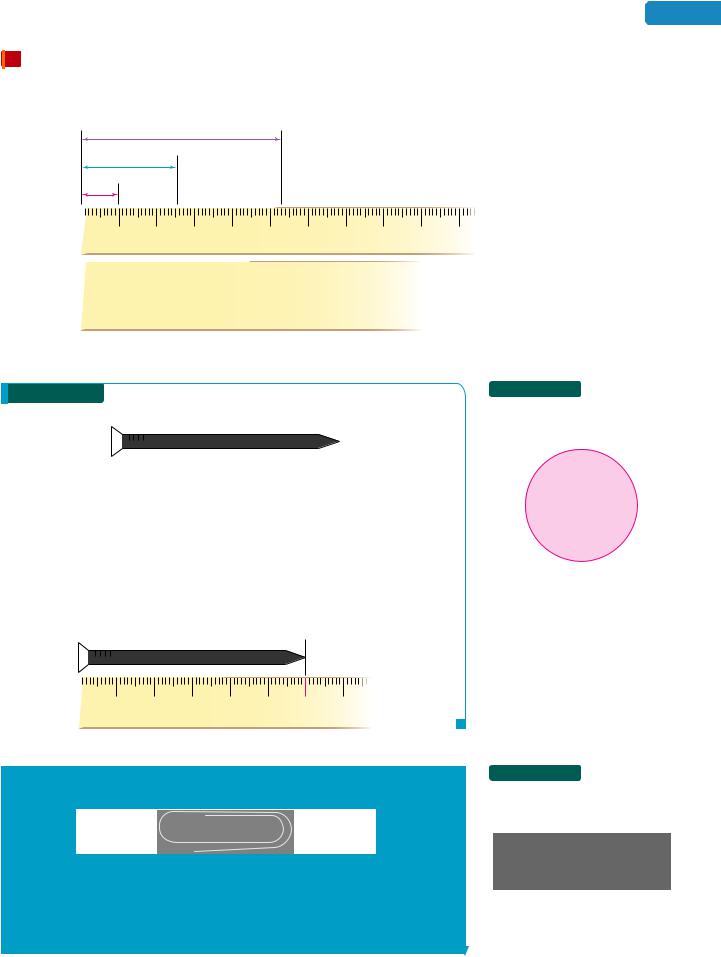
5.4 Metric Units of Measurement |
457 |
2 Use a metric ruler to measure lengths.
Parts of a metric ruler, scaled in centimeters, and a ruler scaled in inches are shown below. Several lengths on the metric ruler are highlighted.
53 mm
2.54 cm = 1 in.
1 cm
Metric system |
1 |
|
|
|
2 |
3 |
|
|
|
|
4 |
|
|
5 |
|
|
|
|
6 |
|
7 |
|
8 |
|
|
|
|
9 |
10 |
||||||||||||||||||||||||||||
|
|
|
|
|
|
|
|
|
|
|
|
|
|
|
|
|
|
|
|
||||||||||||||||||||||||||||||||||||||
|
Centimeters |
|
|
|
|
|
|
|
|
|
|
|
|
|
|
|
|
|
|
|
|
|
|
|
|
|
|
|
|
|
|
|
|
|
|
|
|
|
|
|
|
|
|
|
|
|
|
|
|
||||||||
American system |
|
|
|
|
|
|
|
|
|
|
|
|
|
|
|
|
|
|
|
|
|
|
|
|
|
|
|
|
|
|
|
|
|
|
|
|
|
|
|
|
|
|
|
|
|
|
|
|
|
|
|
|
|
|
|
|
|
|
|
|
|
|
|
|
|
|
|
|
|
|
|
|
|
|
|
|
|
|
|
|
|
|
|
|
|
|
|
|
|
|
|
|
|
|
|
|
|
|
|
|
|
|
|
|
|
|
|
|
|
|
|
|
|
|
|
|
|
|
|
|
|
|
|
|
|
|
|
|
|
|
|
|
|
|
|
|
|
|
|
|
|
|
|
|
|
|
|
|
|
|
|
|
|
|
|
|
|
|
|
|
|
|
|
|
|
|
|
|
|
|
|
|
|
|
|
|
|
|
|
|
|
|
|
|
|
|
1 |
|
|
|
|
|
|
|
|
|
|
|
2 |
|
|
|
|
|
|
|
|
|
|
|
|
|
3 |
|
|
|
|
|
|
|
|
|
|||||||||
|
|
|
|
|
|
|
|
|
|
|
|
|
|
|
|
|
|
|
|
|
|
|
|
|
|
|
|
|
|
|
|
|
|
|
|
|
|
|
|
|
|
|
|
|
|
|
|||||||||||
Inches
(Actual size)
EXAMPLE 1 Find the length of the nail shown below.
Strategy We will place a metric ruler below the nail, with the left end of the ruler (which could be thought of as 0) directly underneath the head of the nail.
WHY Then we can find the length of the nail by identifying where its pointed end lines up on the tick marks printed in black on the ruler.
Solution
The longest tick marks on the ruler (those labeled with numbers) mark lengths in centimeters. Since the pointed end of the nail lines up on 6, the nail is 6 centimeters long.
 Self Check 1
Self Check 1
To the nearest centimeter, find the width of the circle.
Now Try Problem 23
1 2 3 4 5 6 7
Centimeters
EXAMPLE 2 Find the length of the paper clip shown below.
Strategy We will place a metric ruler below the paper clip, with the left end of the ruler (which could be thought of as 0) directly underneath one end of the paper clip.
WHY Then we can find the length of the paper clip by identifying where its other end lines up on the tick marks printed in black on the ruler.
 Self Check 2
Self Check 2
Find the length of the jumbo paper clip.
Now Try Problem 25
Copyright 2010 Cengage Learning, Inc. All Rights Reserved. May not be copied, scanned, or duplicated, in whole or in part.
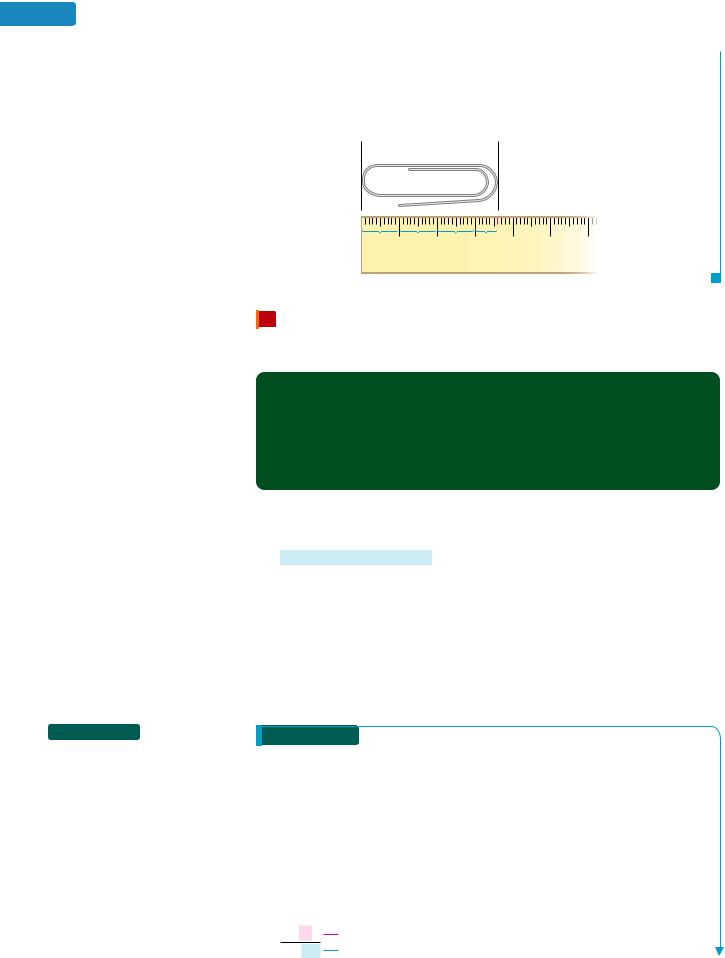
458 |
Chapter 5 Ratio, Proportion, and Measurement |
Solution
 Self Check 3
Self Check 3
Convert 860 centimeters to meters.
Now Try Problem 31
On the ruler, the shorter tick marks divide each centimeter into 10 millimeters, as shown. If we begin at the left end of the ruler and count by tens as we move right to 3, and then add an additional 6 millimeters to that result, we find that the length of the paper clip is 30 + 6 = 36 millimeters.
10 mm 110 mm 2 10 mm 3 6 mm 4 |
5 |
6 |
Centimeters
3 Use unit conversion factors to convert metric units of length.
Metric units of length are related as shown in the following table.
Metric Units of Length
1 kilometer (km) 1,000 meters |
1 meter 10 decimeters (dm) |
1 hectometer (hm) 100 meters |
1 meter 100 centimeters (cm) |
1 dekameter (dam) 10 meters |
1 meter 1,000 millimeters (mm) |
The abbreviation for each unit is written within parentheses.
We can use the information in the table to write unit conversion factors that can be used to convert metric units of length. For example, in the table we see that
1 meter 100 centimeters
From this fact, we can write two unit conversion factors.
|
|
|
|
|
|
To obtain the first unit conversion factor, |
|
1 m |
1 |
and |
100 cm |
1 |
divide both sides of the equation 1 m |
|
100 cm |
1 m |
100 cm by 100 cm. To obtain the second unit |
conversion factor, divide both sides by 1 m.
One advantage of the metric system is that multiplying or dividing by a unit conversion factor involves multiplying or dividing by a power of 10.
EXAMPLE 3 Convert 350 centimeters to meters.
Strategy We will multiply 350 centimeters by a carefully chosen unit conversion factor.
WHY If we multiply by the proper unit conversion factor, we can eliminate the unwanted units of centimeters and convert to meters.
Solution
To convert from centimeters to meters, we must choose a unit conversion factor whose numerator contains the units we want to introduce (meters), and whose denominator contains the units we want to eliminate (centimeters). Since there is 1 meter for every 100 centimeters, we will use
1 m This is the unit we want to introduce.
100 cm This is the unit we want to eliminate (the original unit).
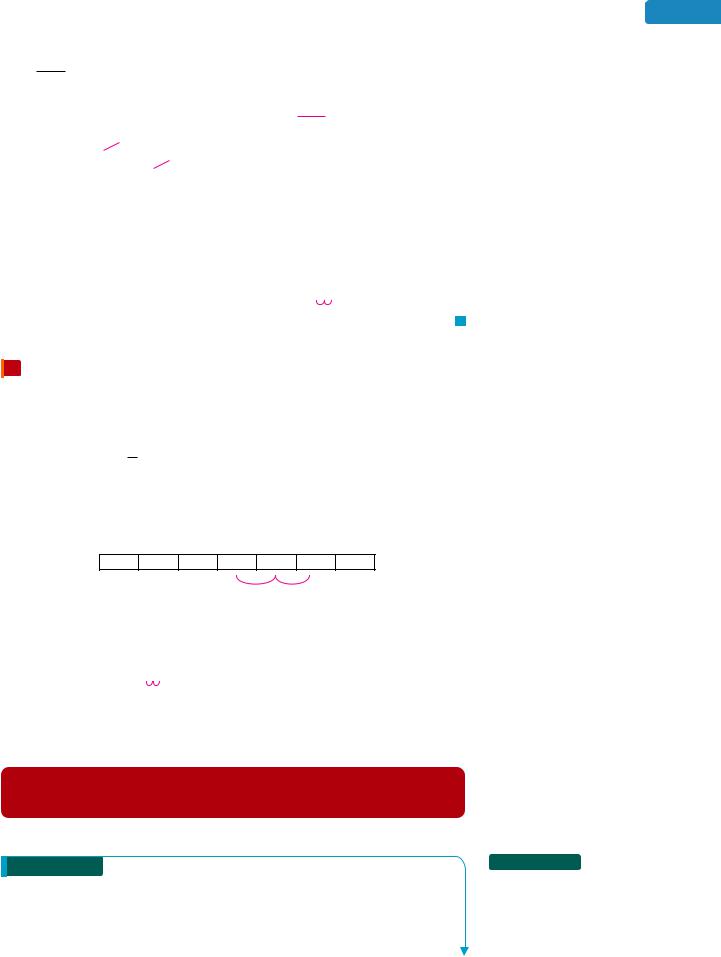
5.4 Metric Units of Measurement |
459 |
To perform the conversion, we multiply 350 centimeters by the unit conversion
1 m
factor 100 cm.
350 cm |
350 cm |
# |
1 m |
||||
|
100 cm |
||||||
|
|
1 |
|
|
|
||
|
|
350 cm |
|
1 m |
|||
|
|
|
|
||||
|
1 |
|
100 cm |
||||
|
|
350 |
m |
|
|
|
|
100 |
|
|
|
||||
|
|
|
|
|
|
|
|
|
|
350.0 |
m |
|
|||
|
|
|
|
||||
100 |
|
||||||
3.5 m
Write 350 cm as a fraction: 350 cm 350 cm .
1
Multiply by a form of 1: 1 m .
100 cm
Remove the common units of centimeters from the numerator and denominator. Notice that the units of meter remain.
Multiply the fractions.
Write the whole number 350 as a decimal by placing a decimal point immediately to its right and entering a zero: 350 350.0
Divide 350.0 by 100 by moving the decimal point 2 places to the left: 3.500.
Thus, 350 centimeters 3.5 meters.
4 Use a conversion chart to convert metric units of length.
In Example 3, we converted 350 centimeters to meters using a unit conversion factor. We can also make this conversion by recognizing that all units of length in the metric system are powers of 10 of a meter.
To see this, review the table of metric units of length on page 456. Note that each unit has a value that is 101 of the value of the unit immediately to its left and 10 times the value of the unit immediately to its right. Converting from one unit to another is as easy as multiplying (or dividing) by the correct power of 10 or, simply moving a decimal point the correct number of places to the right (or left). For example, in the conversion chart below, we see that to convert from centimeters to meters, we move 2 places to the left.
largest unit km hm dam m dm cm mm smallest unit
To go from centimeters to meters, we must move 2 places to the left.
If we write 350 centimeters as 350.0 centimeters, we can convert to meters by moving the decimal point 2 places to the left.
350.0 centimeters 3.500 meters |
3.5 meters |
|
Move 2 places to the left.
With the unit conversion factor method or the conversion chart method, we get 350 cm 3.5 m.
Caution! When using a chart to help make a metric conversion, be sure to list the units from largest to smallest when reading from left to right.
EXAMPLE 4 |
Convert 2.4 meters to millimeters. |
|
Strategy On a conversion chart, we will count the places and note the direction as we move from the original units of meters to the conversion units of millimeters.
WHY The decimal point in 2.4 must be moved the same number of places and in that same direction to find the conversion to millimeters.
 Self Check 4
Self Check 4
Convert 5.3 meters to millimeters.
Now Try Problem 35

460 |
Chapter 5 Ratio, Proportion, and Measurement |
Solution
To construct a conversion chart, we list the metric units of length from largest (kilometers) to smallest (millimeters), working from left to right. Then we locate the original units of meters and move to the conversion units of millimeters, as shown below.
km  hm
hm  dam
dam  m
m  dm
dm  cm
cm  mm
mm
3 places to the right
We see that the decimal point in 2.4 should be moved 3 places to the right to convert from meters to millimeters.
2.4 meters 2 400. millimeters 2,400 millimeters 
Move 3 places to the right.
We can use the unit conversion factor method to confirm this result. Since there are 1,000 millimeters per meter, we multiply 2.4 meters by the unit conversion
1,000 mm
factor 1 m .
2.4m 2.4 m # 1,000 mm
11 m
2.4 m 1,000 mm
11 m
2.4 # 1,000 mm
2,400 mm
Write 2.4 m as a fraction: 2.4 m 2.41 m.
Multiply by a form 1: 1,000 mm .
1 m
Remove the common units of meters from the numerator and denominator. Notice that the units of millimeters remain.
Multiply the fractions and simplify.
Multiply 2.4 by 1,000 by moving the decimal point 3 places to the right: 2 400.
 Self Check 5
Self Check 5
Convert 5.15 centimeters to kilometers.
Now Try Problem 39
EXAMPLE 5 Convert 3.2 centimeters to kilometers.
Strategy On a conversion chart, we will count the places and note the direction as we move from the original units of centimeters to the conversion units of kilometers.
WHY The decimal point in 3.2 must be moved the same number of places and in that same direction to find the conversion to kilometers.
Solution
We locate the original units of centimeters on a conversion chart, and then move to the conversion units of kilometers, as shown below.
km  hm
hm  dam
dam  m
m  dm
dm  cm
cm  mm
mm
5 places to the left
We see that the decimal point in 3.2 should be moved 5 places to the left to convert centimeters to kilometers.
3.2 centimeters = 0.000032 |
kilometers = 0.000032 kilometers |
Move 5 places to the left.
We can use the unit conversion factor method to confirm this result.To convert to kilometers, we must use two unit conversion factors so that the units of centimeters drop out and the units of kilometers remain. Since there is 1 meter for
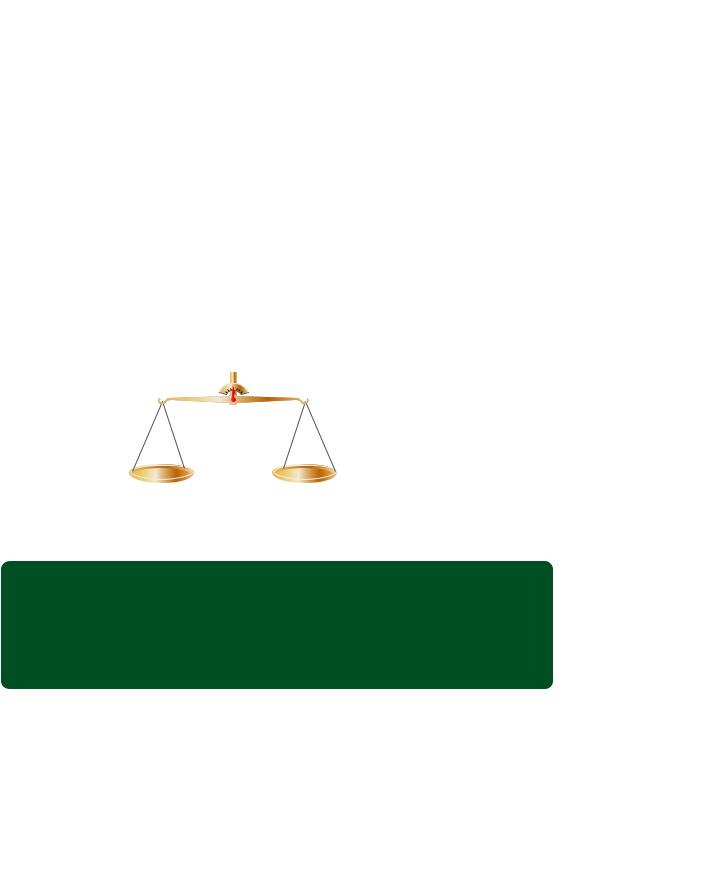
5.4 Metric Units of Measurement |
461 |
every 100 centimeters and 1 kilometer for every 1,000 meters, we multiply by |
1 m |
|||
100 cm |
||||
and |
1 km |
. |
||
|
||||
|
|
|||
|
1,000 m |
|
||
3.2 cm |
3.2 cm |
|
1 m |
|
1 km |
1 |
100 cm |
1,000 m |
3.2
100 1,000 km
0.000032 km
Remove the common units of centimeters and meters. The units of km remain.
Multiply the fractions.
Divide 3.2 by 1,000 and 100 by moving the decimal point 5 places to the left.
5 Define metric units of mass.
The mass of an object is a measure of the amount of material in the object. When an object is moved about in space, its mass does not change. One basic unit of mass in the metric system is the gram (g). A gram is defined to be the mass of water contained in a cube having sides 1 centimeter long. (See the figure below.)
1 cubic |
|
centimeter |
|
of water |
1g |
Other units of mass are created by adding prefixes to the front of the basic unit, gram.
Metric Units of Mass
Prefix |
kilo- |
hecto- |
deka- |
|
|
deci- |
centi- |
milli- |
|||
|
gram |
gram |
gram |
gram |
|
gram |
gram |
gram |
|||
Meaning |
1,000 |
100 |
10 |
1 |
|
1 |
or 0.1 |
1 |
or 0.01 |
1 |
or 0.001 |
10 |
100 |
1,000 |
|||||||||
|
grams |
grams |
grams |
gram |
of a gram |
of a gram |
of a gram |
||||
Abbreviation |
kg |
hg |
dag |
g |
|
|
dg |
|
cg |
|
mg |
|
|
|
|
|
|
|
|
|
|
|
|
The most often used metric units of mass are kilograms, grams, and milligrams. Some examples are shown below.
n
C
An average bowling ball weighs |
A raisin weighs |
A certain vitamin tablet contains |
about 6 kilograms. |
about 1 gram. |
450 milligrams of calcium. |
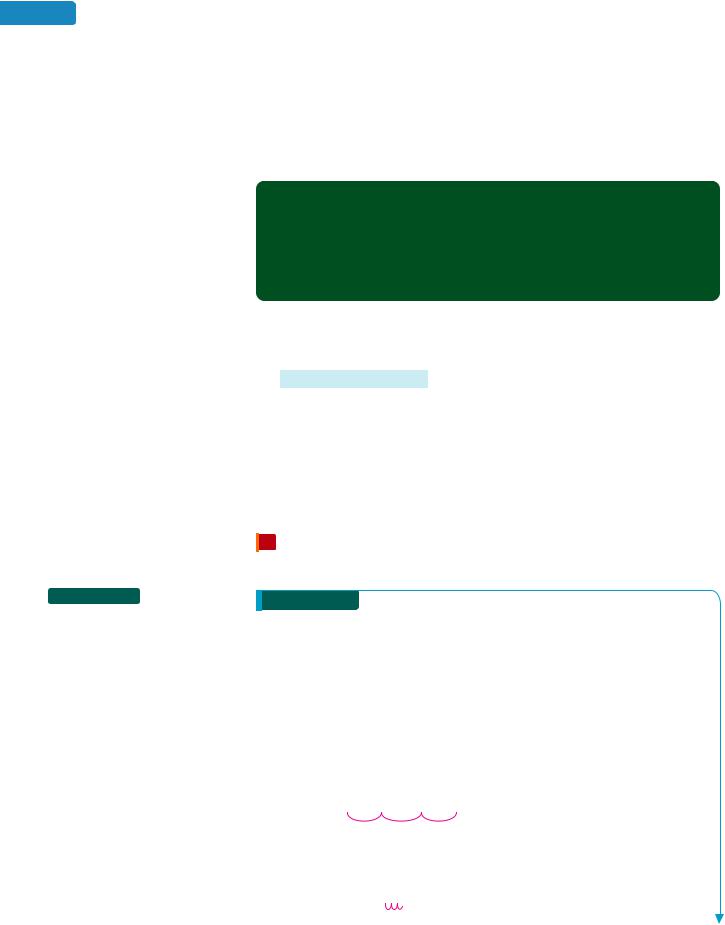
462 |
Chapter 5 Ratio, Proportion, and Measurement |
The weight of an object is determined by the Earth’s gravitational pull on the object. Since gravitational pull on an object decreases as the object gets farther from Earth, the object weighs less as it gets farther from Earth’s surface. This is why astronauts experience weightlessness in space. However, since most of us remain near Earth’s surface, we will use the words mass and weight interchangeably. Thus, a mass of 30 grams is said to weigh 30 grams.
Metric units of mass are related as shown in the following table.
Metric Units of Mass
1 kilogram (kg) 1,000 grams |
1 gram 10 decigrams (dg) |
1 hectogram (hg) 100 grams |
1 gram 100 centigrams (cg) |
1 dekagram (dag) 10 grams |
1 gram 1,000 milligrams (mg) |
The abbreviation for each unit is written within parentheses.
We can use the information in the table to write unit conversion factors that can be used to convert metric units of mass. For example, in the table we see that
1 kilogram 1,000 grams
From this fact, we can write two unit conversion factors.
|
1 kg |
|
1,000 g |
||
|
|
1 |
and |
|
1 |
1,000 g |
1 kg |
||||
|
|
|
|
|
|
To obtain the first unit conversion factor, divide both sides of the equation 1 kg 1,000 g by 1,000 g. To obtain the
second unit conversion factor, divide both sides by 1 kg.
 Self Check 6
Self Check 6
Convert 5.83 kilograms to grams.
Now Try Problem 43
6 Convert from one metric unit of mass to another.
EXAMPLE 6 Convert 7.86 kilograms to grams.
Strategy On a conversion chart, we will count the places and note the direction as we move from the original units of kilograms to the conversion units of grams.
WHY The decimal point in 7.86 must be moved the same number of places and in that same direction to find the conversion to grams.
Solution
To construct a conversion chart, we list the metric units of mass from largest (kilograms) to smallest (milligrams), working from left to right. Then we locate the original units of kilograms and move to the conversion units of grams, as shown below.
largest unit |
kg |
hg |
dag |
g |
dg |
cg |
mg |
smallest unit |
|
|
|
|
|
|
|
|
|
3 places to the right
We see that the decimal point in 7.86 should be moved 3 places to the right to change kilograms to grams.
7.86 kilograms 7 860. grams 7,860 grams
Move 3 places to the right.

5.4 Metric Units of Measurement |
463 |
We can use the unit conversion factor method to confirm this result.To convert to grams, we must chose a unit conversion factor such that the units of kilograms
drop out and the units of grams remain. Since there are 1,000 grams per 1 kilogram, we multiply 7.86 kilograms by 1,0001 kgg.
7.86 kg |
7.86 kg |
|
1,000 g |
1 |
1 kg |
7.86 # 1,000 g
7,860 g
Remove the common units of kilograms in the numerator and denominator. The units of g remain.
Simplify.
Multiply 7.86 by 1,000 by moving the decimal point 3 places to the right.
Medications A bottle of Verapamil, a drug taken for high blood pressure, contains 30 tablets. If each tablet has 180 mg of active ingredient, how many grams of active ingredient are in the bottle?
Strategy We will multiply the number of tablets in one bottle by the number of milligrams of active ingredient in each tablet.
WHY We need to know the total number of milligrams of active ingredient in one bottle before we can convert that number to grams.
 Self Check 7
Self Check 7
MEDICATIONS A bottle of Isoptin (a drug taken for high blood pressure) contains
90 tablets, and each has 200 mg of active ingredient, how many grams of active ingredient are in the bottle?
Solution
Since there are 30 tablets, and each one contains 180 mg of active ingredient, there are
30 # 180 mg 5,400 mg 5400.0 mg
180Now Try Problems 47 and 95
30
000
5400
5,400
of active ingredient in the bottle. To use a conversion chart to solve this problem, we locate the original units of milligrams and then move to the conversion units of grams, as shown below.
kg |
hg |
dag |
g |
dg |
cg |
mg |
|
|
|
|
|
|
|
3 places to the left
We see that the decimal point in 5,400.0 should be moved 3 places to the left to convert from milligrams to grams.
5,400 milligrams 5.400 grams
Move3 places to the left.
There are 5.4 grams of active ingredient in the bottle.
We can use the unit conversion factor method to confirm this result. To
1 g
convert milligrams to grams, we multiply 5,400 milligrams by 1,000 mg .
5,400 mg |
5,400 mg |
|
1 g |
1 |
1,000 mg |
5,4001,000 g
5.4 g
Remove the common units of milligrams from the numerator and denominator. The units of g remain.
Multiply the fractions.
Divide 5,400 by 1,000 by moving the understood decimal point in 5,400 three places to the left.
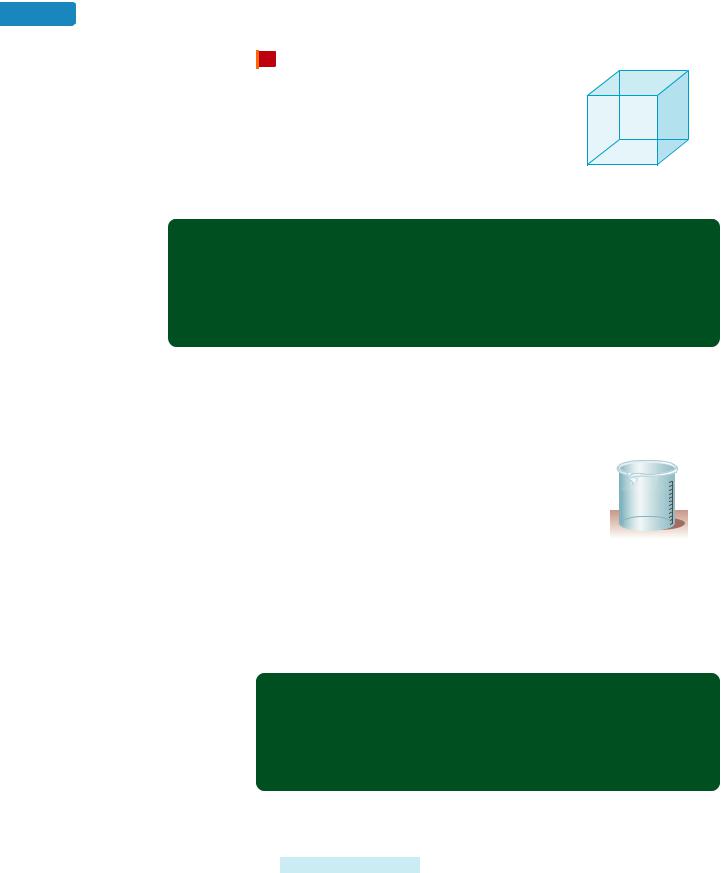
464 |
Chapter 5 Ratio, Proportion, and Measurement |
7 Define metric units of capacity.
In the metric system, one basic unit of capacity is the liter (L), which is defined to be the capacity of a cube with sides 10 centimeters long. Other units of capacity are created by adding prefixes to the front of the basic unit, liter.
10 cm
10 cm
10 cm
Metric Units of Capacity
Prefix |
kilo- |
hecto- |
deka- |
|
|
deci- |
centi- |
milli- |
|||
|
liter |
liter |
liter |
liter |
|
|
liter |
|
liter |
|
liter |
Meaning |
1,000 |
100 |
10 |
1 |
|
1 |
or 0.1 |
1 |
or 0.01 |
1 |
or 0.001 |
10 |
100 |
1,000 |
|||||||||
|
liters |
liters |
liters |
liter |
of a liter |
of a liter |
of a liter |
||||
Abbreviation |
kL |
hL |
daL |
L |
|
|
dL |
|
cL |
|
mL |
|
|
|
|
|
|
|
|
|
|
|
|
The most often used metric units of capacity are liters and milliliters. Here are some examples.

 PREMIUM
PREMIUM
$ $
$
|
n |
o |
|
o |
|
sp |
|
a |
|
Te |
|
COLA
Soft drinks are |
The fuel tank of a minivan |
A teaspoon holds |
sold in 2-liter |
can hold about 75 liters |
about 5 milliliters. |
plastic bottles. |
of gasoline. |
|
Metric units of capacity are related as shown in the following table.
Metric Units of Capacity
1 kiloliter (kL) 1,000 liters |
1 liter 10 deciliters (dL) |
1 hectoliter (hL) 100 liters |
1 liter 100 centiliters (cL) |
1 dekaliter (daL) 10 liters |
1 liter 1,000 milliliters (mL) |
The abbreviation for each unit is written within parentheses.
We can use the information in the table to write unit conversion factors that can be used to convert metric units of capacity. For example, in the table we see that
1 liter 1,000 milliliters
From this fact, we can write two unit conversion factors.
|
1 L |
1 |
and |
1,000 mL |
1 |
|
1,000 mL |
1 L |
|||
|
|
|
|
|
|

5.4 Metric Units of Measurement |
465 |
8 Convert from one metric unit of capacity to another.
|
EXAMPLE 8 |
Soft Drinks How many milliliters are in three 2-liter |
bottles of cola? |
|
|
Strategy We will multiply the number of bottles of cola by the number of liters of cola in each bottle.
WHY We need to know the total number of liters of cola before we can convert that number to milliliters.
Solution
Since there are three bottles, and each contains 2 liters of cola, there are
3 2 L 6 L 6.0 L
of cola in the bottles. To construct a conversion chart, we list the metric units of capacity from largest (kiloliters) to smallest (milliliters), working from left to right. Then we locate the original units of liters and move to the conversion units of milliliters, as shown below.
largest unit |
kL |
hL |
daL |
L |
dL |
cL |
mL |
smallest unit |
|
|
|
|
|
|
|
|
|
3 places to the right
We see that the decimal point in 6.0 should be moved 3 places to the right to convert from liters to milliliters.
6 liters 6 000. milliliters 6,000 milliliters 
Move 3 places to the right.
Thus, there are 6,000 milliliters in three 2-liter bottles of cola.
We can use the unit conversion factor method to confirm this result.To convert to milliliters, we must chose a unit conversion factor such that liters drop out and the units of milliliters remain. Since there are 1,000 milliliters per 1 liter, we
multiply 6 liters by the unit conversion factor 1,000 mL. |
|
|||||
|
|
|
|
|
1 L |
|
6 L |
|
6 L |
1,000 mL |
Remove the common units of liters in the numerator |
|
|
|
|
|
|
and denominator. The units of mL remain. |
|
|
|
1 |
1 L |
|
|||
|
6 # 1,000 mL |
Simplify. |
|
|||
|
6,000 mL |
Multiply 6 by 1,000 by moving the understood decimal |
|
|||
point in 6 three places to the right. |
|
|||||
|
|
|
|
|
|
|
9 Define a cubic centimeter.
Another metric unit of capacity is the cubic centimeter, which is represented by the notation cm3 or, more simply, cc. One milliliter and one cubic centimeter represent the same capacity.
1 mL 1 cm3 1 cc
The units of cubic centimeters are used frequently in medicine. For example, when a nurse administers an injection containing 5 cc of medication, the dosage can also be expressed using milliliters.
5 cc 5 mL
 Self Check 8
Self Check 8
SOFT DRINKS How many milliliters are in a case of twelve 2-liter bottles of cola?
Now Try Problems 51 and 97
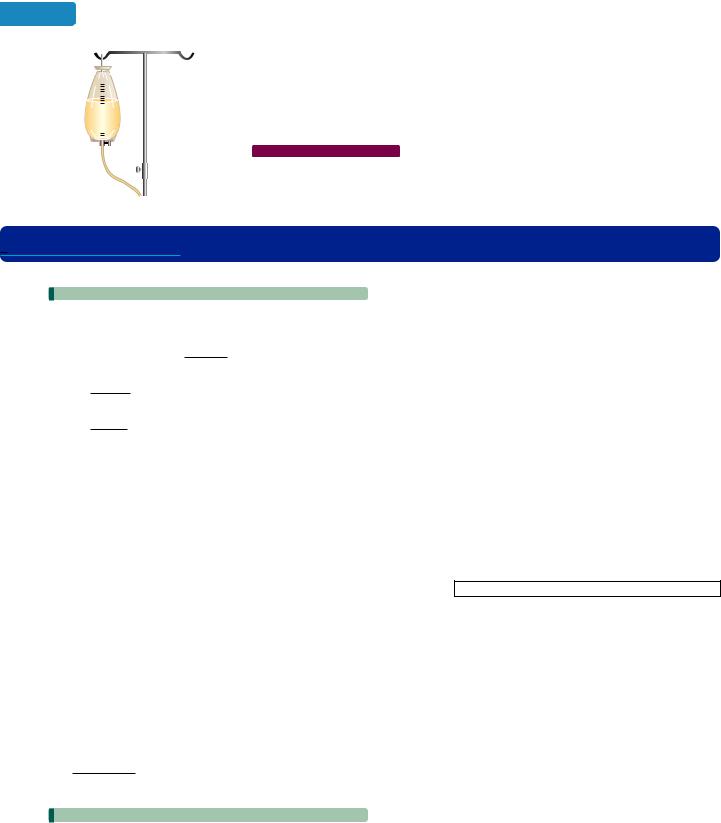
466 |
Chapter 5 Ratio, Proportion, and Measurement |
||||
|
|
|
|
When a doctor orders that a patient be put on 1,000 cc of dextrose solution, the |
|
|
|
|
|
request can be expressed in different ways. |
|
|
|
|
|
1,000 cc 1,000 mL 1 liter |
|
|
|
|
|
||
|
|
|
|
||
|
|
|
|
|
|
|
Dextrose |
|
|||
|
5% |
|
|
||
|
1,000 cc |
|
|||
|
|
|
|
|
|
|
|
|
|
ANSWERS TO SELF CHECKS |
|
|
|
|
|
||
|
|
|
|
1. |
3 cm 2. 47 mm 3. 8.6 m 4. 5,300 mm 5. 0.0000515 km 6. 5,830 g 7. 1.8 g |
|
|
|
|
8. |
24,000 mL |
|
|
|
|
|
|
 S E C T I O N 5.4 STUDY SET
S E C T I O N 5.4 STUDY SET
VOCABULARY
Fill in the blanks.
1. The meter, the gram, and the liter are basic units of measurement in the system.
2. a. The basic unit of length in the metric system is the
.
b.The basic unit of mass in the metric system is the
.
c.The basic unit of capacity in the metric system is
|
|
the |
|
|
. |
|
|
|
|
|
|
|
|
|
|
|
|
|
|
|
|||
3. |
a. |
Deka means |
|
. |
|
|
|
|
|
|
|
|
|
|
|||||||||
|
b. |
Hecto means |
|
|
|
|
|
|
. |
|
|
|
|
|
|||||||||
|
c. |
Kilo means |
|
|
|
|
|
. |
|
|
|
|
|
|
|||||||||
4. |
a. |
Deci means |
|
|
. |
|
|
|
|
|
|
|
|
|
|||||||||
|
|
|
|
|
|
|
|
|
|
|
|
|
|
|
|
|
|
||||||
|
b. |
Centi means |
|
|
|
|
|
|
. |
|
|
|
|
||||||||||
|
c. |
Milli means |
|
|
|
|
|
. |
|
|
|
|
|||||||||||
|
|
|
|
|
|
|
|
|
|
|
|||||||||||||
5. |
We can convert from one unit to another in the |
||||||||||||||||||||||
|
metric system using |
|
|
|
|
conversion factors or a |
|||||||||||||||||
|
conversion |
|
|
|
|
|
|
like that shown below. |
|||||||||||||||
|
|
|
|
|
|
|
|
|
|
|
|
|
|
|
|
|
|
|
|
|
|
|
|
|
|
|
km |
|
|
|
hm |
dam |
|
|
|
m |
dm |
cm |
mm |
|
|||||||
6. |
The |
|
|
of an object is a measure of the amount of |
|||||||||||||||||||
|
material in the object. |
|
|
|
|
|
|
|
|
|
|||||||||||||
7. |
The |
|
|
|
|
of an object is determined by the Earth’s |
|||||||||||||||||
|
gravitational pull on the object. |
|
|
|
|
||||||||||||||||||
8.Another metric unit of capacity is the cubic
,which is represented by the notation cm3, or, more simply, cc.
CONCEPTS
Fill in the blanks.
9.a. 1 kilometer  meters
meters
b. centimeters 1 meter
centimeters 1 meter
c. millimeters 1 meter
millimeters 1 meter
10.a. 1 gram  milligrams
milligrams
b.1 kilogram  grams
grams
11.a.  milliliters 1 liter
milliliters 1 liter
b.1 dekaliter  liters
liters
12.a. 1 milliliter  cubic centimeter
cubic centimeter
b.1 liter  cubic centimeters
cubic centimeters
13.Write a unit conversion factor to convert
a.meters to kilometers
b.grams to centigrams
c.liters to milliliters
14.Use the chart to determine how many decimal places and in which direction to move the decimal point when converting the following.
a.Kilometers to centimeters
km  hm
hm  dam
dam  m
m  dm
dm  cm
cm  mm
mm
b. Milligrams to grams
|
kg |
hg |
dag |
|
g |
dg |
cg |
mg |
c. Hectoliters to centiliters |
|
|
|
|
||||
|
|
|
|
|
|
|
|
|
|
kL |
hL |
daL |
|
L |
dL |
cL |
mL |
15. Match each item with its proper measurement.
a. |
Thickness of a |
i. |
6,275 km |
|
phone book |
ii. |
2 m |
|
|
||
b. |
Length of the |
iii. 6 cm |
|
|
|
||
Amazon River
c.Height of a soccer goal
16.Match each item with its proper measurement.
a. |
Weight of a giraffe |
i. |
800 kg |
b. |
Weight of a paper |
ii. |
1 g |
|
clip |
iii. 325 mg |
|
|
|
||
c.Active ingredient in an aspirin tablet
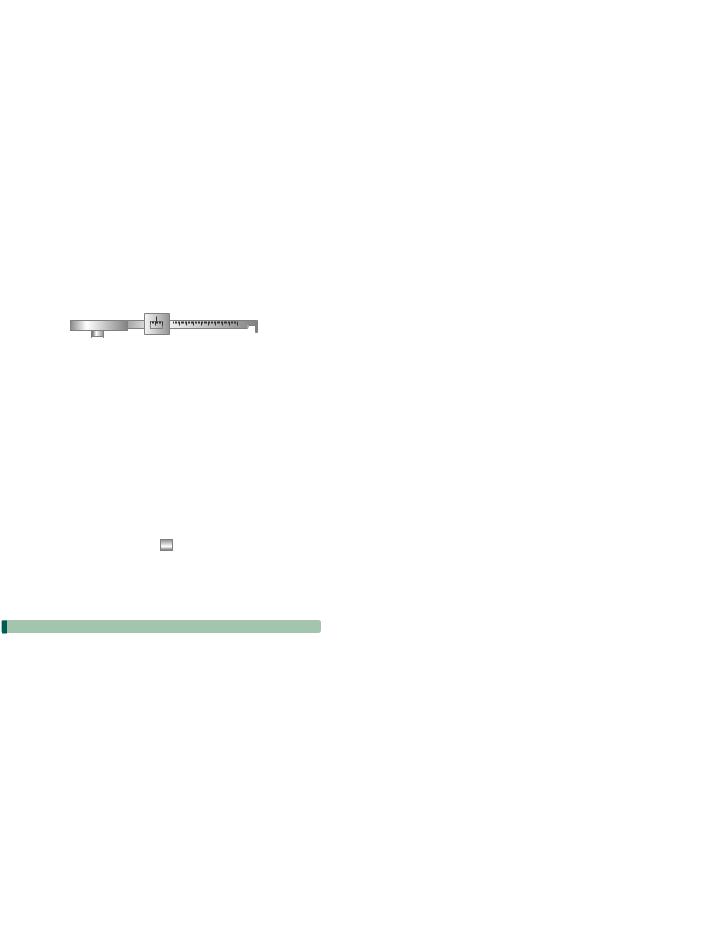
17. Match each item with its proper measurement.
a.Amount of blood in an adult
b.Cola in an aluminum can
c.Kuwait’s daily production of crude oil
i.290,000 kL
ii.6 L
iii.355 mL
18.Of the objects shown below, which can be used to measure the following?
a.Millimeters
b.Milligrams
c.Milliliters
Balance
Beaker
500 400 300 200 100
Micrometer
NOTATION
Complete each solution.
19. Convert 20 centimeters to meters.
20 cm |
20 cm |
|
|
|
m |
|||
|
|
|
|
|||||
1 |
|
|
100 cm |
|||||
|
20 |
|
m |
|
|
|
|
|
|
|
|
|
|
|
|||
|
|
|
|
|
|
|
|
|
|
|
m |
|
|
|
|
||
|
|
|
|
|
||||
20. Convert 3,000 milligrams to grams.
3,000 mg |
3,000 mg |
|
1 g |
||||||
1 |
|
|
|
1,000 |
|
|
|||
|
3,000 |
|
|
|
|
|
|
|
|
|
|
|
|
|
|
|
|
||
1,000 |
|
|
|
|
|
|
|
||
|
|
|
|
|
|
|
|||
|
|
g |
|
|
|
|
|||
|
|
|
|
|
|||||
|
|
|
5.4 |
Metric Units of Measurement |
467 |
||||||||||||||
21. |
Convert 0.2 kilograms to milligrams. |
|
|||||||||||||||||
|
0.2 kg |
0.2 kg |
|
|
|
g 1,000 mg |
|
||||||||||||
|
|
|
|
|
|||||||||||||||
|
|
|
|
|
|
|
|
|
|
|
|
|
|
|
|
|
|
|
|
|
|
1 |
1 kg |
|
|
|
|
|
g |
|
|||||||||
|
0.2 1,000 1,000 |
|
|
|
|
|
|
|
|
|
|
||||||||
|
|
|
|
|
|
|
|
|
|
|
|||||||||
|
|
|
|
|
mg |
|
|
|
|
|
|
|
|
|
|
|
|
|
|
|
|
|
|
|
|
|
|
|
|
|
|
|
|
|
|
|
|||
22. |
Convert 400 milliliters to kiloliters. |
|
|
|
|
|
|
|
|||||||||||
|
400 mL |
400 mL |
|
|
1 L |
|
|
1 |
|
|
|
|
|
||||||
|
|
|
|
|
|
|
|||||||||||||
|
|
|
|
|
|
||||||||||||||
|
|
|
|
|
mL |
1,000 L |
|
||||||||||||
|
|
|
1 |
|
|
|
|
|
|
|
|||||||||
1,000 1,000 kL
0.0004 kL
GUIDED PRACTICE
Refer to the given ruler to answer each question. See Example 1.
23.Determine which measurements the arrows point to on the metric ruler.
1 |
2 |
3 |
4 |
5 |
6 |
7 |
Centimeters
24.Find the length of the birthday candle (including the wick).
1 |
2 |
3 |
4 |
5 |
6 |
7 |
Centimeters
Refer to the given ruler to answer each question. See Example 2.
25.a. Refer to the metric ruler below. Each centimeter is divided into how many equal parts? What is the length of one of those parts?
b.Determine which measurements the arrows point to on the ruler.
1 |
2 |
3 |
4 |
5 |
6 |
7 |
Centimeters
26. Find the length of the stick of gum.
WRIGLEY’S’S
DOUBLEMINTI
1 |
2 |
3 |
4 |
5 |
6 |
7 |
Centimeters

468 |
Chapter 5 Ratio, Proportion, and Measurement |
Use a metric ruler scaled in millimeters to measure each object.
See Example 2.
27.The length of a dollar bill
28.The width of a dollar bill
29.The length (top to bottom) of this page
30.The length of the word antidisestablishmentarianism as printed here.
Perform each conversion. See Example 3.
31.380 centimeters to meters
32.590 centimeters to meters
33.120 centimeters to meters
34.640 centimeters to meters
Perform each conversion. See Example 4.
35.8.7 meters to millimeters
36.1.3 meters to millimeters
37.2.89 meters to millimeters
38.4.06 meters to millimeters
Perform each conversion. See Example 5.
39.4.5 centimeters to kilometers
40.6.2 centimeters to kilometers
41.0.3 centimeters to kilometers
42.0.4 centimeters to kilometers
Perform each conversion. See Example 6.
43.1.93 kilograms to grams
44.8.99 kilograms to grams
45.4.531 kilograms to grams
46.6.077 kilograms to grams
Perform each conversion. See Example 7.
47.6,000 milligrams to grams
48.9,000 milligrams to grams
49.3,500 milligrams to grams
50.7,500 milligrams to grams
Perform each conversion. See Example 8.
51.3 liters to milliliters
52.4 liters to milliliters
53.26.3 liters to milliliters
54.35.2 liters to milliliters
TRY IT YOURSELF
Perform each conversion.
55.0.31 decimeters to centimeters
56.73.2 meters to decimeters
57.500 milliliters to liters
58.500 centiliters to milliliters
59.2 kilograms to grams
60.4,000 grams to kilograms
61.0.074 centimeters to millimeters
62.0.125 meters to millimeters
63.1,000 kilograms to grams
64.2 kilograms to centigrams
65.658.23 liters to kiloliters
66.0.0068 hectoliters to kiloliters
67.4.72 cm to dm
68.0.593 cm to dam
69. |
10 mL |
|
|
|
cc |
70. |
2,000 cc |
|
|
L |
|
71.500 mg to g
72.500 mg to cg
73.5,689 g to kg
74.0.0579 km to mm
75.453.2 cm to m
76.675.3 cm to m
77.0.325 dL to L
78.0.0034 mL to L
79. |
675 dam |
|
|
cm |
|||
80. |
76.8 hm |
|
|
|
mm |
||
81. |
0.00777 cm |
|
|
|
dam |
||
82.400 liters to hL
83.134 m to hm
84.6.77 mm to cm
85.65.78 km to dam
86.5 g to cg
APPLICATIONS
87.SPEED SKATING American Eric Heiden won an unprecedented five gold medals by capturing the men’s 500-m, 1,000-m, 1,500-m, 5,000-m, and 10,000-m races at the 1980 Winter Olympic Games in Lake Placid, New York. Convert each race length to kilometers.

88.THE SUEZ CANAL The 163-km-long Suez Canal connects the Mediterranean Sea with the Red Sea. It provides a shortcut for ships operating between European and American ports. Convert the length of the Suez Canal to meters.
|
SYRIA |
|
|
Mediterranean |
|
|
|
Sea |
IRAQ |
|
|
|
|
IRAN |
|
|
Suez Canal |
|
|
|
|
|
|
EGYPT |
|
Persian |
Gulf |
|
|
||
|
|
|
|
|
SAUDI ARABIA |
U.A.E. |
|
|
|
OMAN |
|
|
|
|
|
SUDAN |
Red |
|
|
|
Sea |
|
|
|
YEMEN |
|
Indian |
|
ETHIOPIA |
|
Ocean |
|
|
|
|
89.SKYSCRAPERS The John Hancock Center in Chicago has 100 stories and is 343 meters high. Give this height in hectometers.
90.WEIGHT OF A BABY A baby weighs 4 kilograms. Give this weight in centigrams.
91.HEALTH CARE Blood
pressure is measured by a sphygmomanometer (see
at right). The measurement is read at two points
and is expressed, for example, as 120/80. This indicates a systolic pressure of 120 millimeters of mercury and a diastolic
pressure of 80 millimeters of mercury. Convert each measurement to centimeters of mercury.
92. JEWELRY A gold chain weighs 1,500 milligrams. Give this weight in grams.
93. EYE DROPPERS One drop from an eye dropper is 0.05 mL. Convert the capacity of one drop to liters.
94. BOTTLING How many liters of wine are in a 750-mL bottle?
95. MEDICINE A bottle of hydrochlorothiazine contains 60 tablets. If each tablet contains 50 milligrams of active ingredient, how many grams of active ingredient are in the bottle?
96. IBUPROFEN |
|
f |
|
|
|
|
|
||
|
e |
|
|
|
|
|
|
||
What is the total |
li |
|
|
|
|
|
|
||
R n |
mg |
|
|
|
|||||
1 |
|
0 |
ts |
|
|
||||
|
e |
|
|
f |
|||||
|
o |
20 |
|
e |
|
|
|||
|
|
abl |
|
|
|||||
|
fe |
|
t |
|
|
|
|
||
|
r |
|
d |
|
|
|
|
||
|
u |
|
te |
|
|
|
|
e |
|
|
p |
coa |
|
|
|
|
|||
|
Ib |
|
|
|
|
||||
|
5 |
|
|
|
|
|
|||
|
6 |
|
|
|
|
|
|
||
|
|
|
|
|
|
|
|
||
|
|
|
|
|
|
|
i |
|
|
weight, in grams, |
R |
|
l |
|
mg |
||||
of all the tablets |
|
|
e |
|
200 |
|
|||
in the box shown |
Ibuprofen |
|
|
||||||
tablets |
|
||||||||
at right? |
165 |
|
ted |
|
|||||
|
|
|
|
|
|||||
|
|
|
coa |
|
|
|
|
|
|
5.4 Metric Units of Measurement |
469 |
97.SIX PACKS Some stores sell Fanta orange soda in 0.5 liter bottles. How many milliliters are there in a six pack of this size bottle?
98.CONTAINERS How many deciliters of root beer are in two 2-liter bottles?
99.OLIVES The net weight of a bottle of olives is 284 grams. Find the smallest number of bottles that must be purchased to have at least 1 kilogram of olives.
100.COFFEE A can of Cafe Vienna has a net weight of 133 grams. Find the smallest number of cans that must be packaged to have at least 1 metric ton of coffee. (Hint: 1 metric ton 1,000 kg.)
101.INJECTIONS The illustration below shows a 3cc syringe. Express its capacity using units of milliliters.
Flange
}Tip
|
|
3cc 21/2 2 |
11/2 1 1/2 |
0 |
|
|
|||
Plunger |
||||
Capacity
102.MEDICAL SUPPLIES A doctor ordered 2,000 cc of a saline (salt) solution from a pharmacy. How many liters of saline solution is this?
WRITING
103.To change 3.452 kilometers to meters, we can move the decimal point in 3.452 three places to the right to get 3,452 meters. Explain why.
104.To change 7,532 grams to kilograms, we can move the decimal point in 7,532 three places to the left to get 7.532 kilograms. Explain why.
105.A centimeter is one hundredth of a meter. Make a list of five other words that begin with the prefix centi or cent and write a definition for each.
106.List the advantages of the metric system of measurement as compared to the American system. There have been several attempts to bring the metric system into general use in the United States. Why do you think these efforts have been unsuccessful?
REVIEW
Write each fraction as a decimal. Use an overbar in your answer.
107. |
8 |
|
108. |
11 |
9 |
|
12 |
||
109. |
7 |
110. |
1 |
|
90 |
66 |
|||
